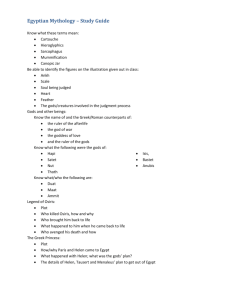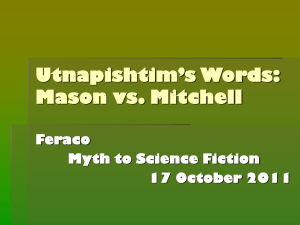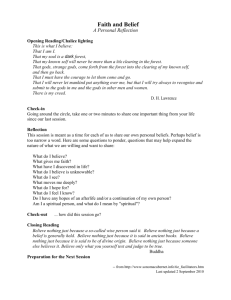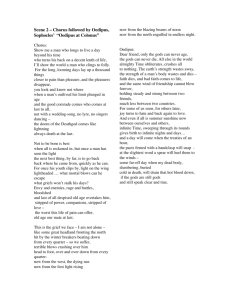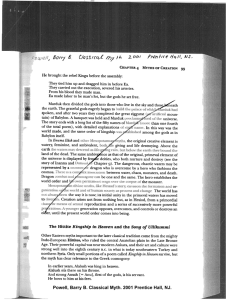Ancient Hawaiian Religion and Legends
advertisement
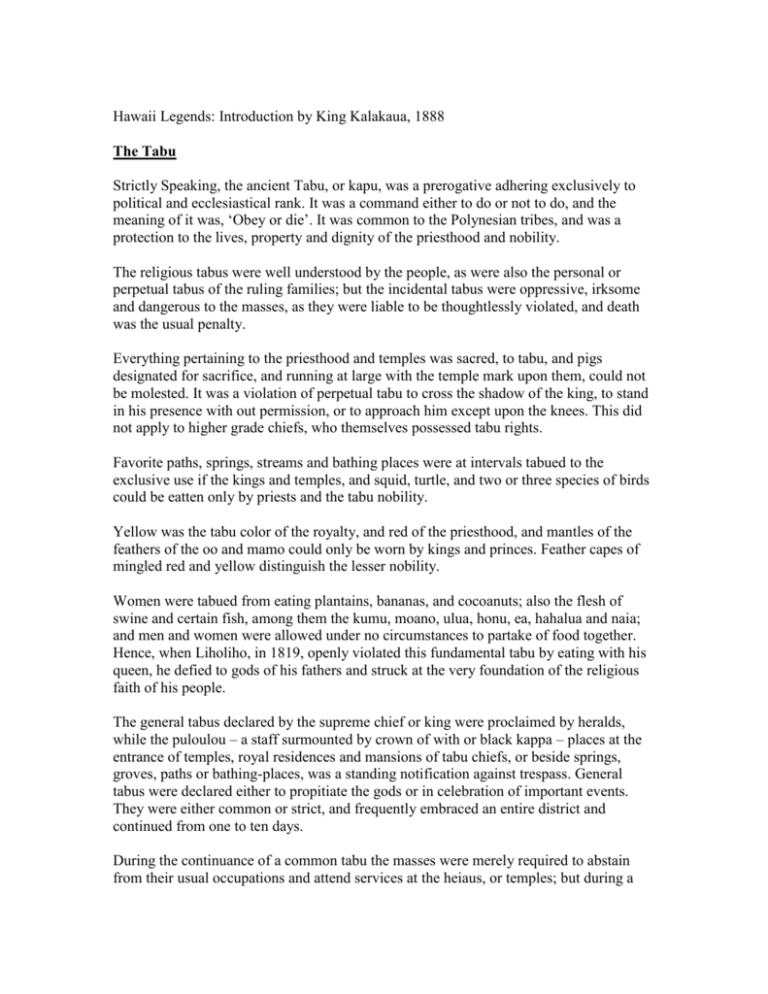
Hawaii Legends: Introduction by King Kalakaua, 1888 The Tabu Strictly Speaking, the ancient Tabu, or kapu, was a prerogative adhering exclusively to political and ecclesiastical rank. It was a command either to do or not to do, and the meaning of it was, ‘Obey or die’. It was common to the Polynesian tribes, and was a protection to the lives, property and dignity of the priesthood and nobility. The religious tabus were well understood by the people, as were also the personal or perpetual tabus of the ruling families; but the incidental tabus were oppressive, irksome and dangerous to the masses, as they were liable to be thoughtlessly violated, and death was the usual penalty. Everything pertaining to the priesthood and temples was sacred, to tabu, and pigs designated for sacrifice, and running at large with the temple mark upon them, could not be molested. It was a violation of perpetual tabu to cross the shadow of the king, to stand in his presence with out permission, or to approach him except upon the knees. This did not apply to higher grade chiefs, who themselves possessed tabu rights. Favorite paths, springs, streams and bathing places were at intervals tabued to the exclusive use if the kings and temples, and squid, turtle, and two or three species of birds could be eatten only by priests and the tabu nobility. Yellow was the tabu color of the royalty, and red of the priesthood, and mantles of the feathers of the oo and mamo could only be worn by kings and princes. Feather capes of mingled red and yellow distinguish the lesser nobility. Women were tabued from eating plantains, bananas, and cocoanuts; also the flesh of swine and certain fish, among them the kumu, moano, ulua, honu, ea, hahalua and naia; and men and women were allowed under no circumstances to partake of food together. Hence, when Liholiho, in 1819, openly violated this fundamental tabu by eating with his queen, he defied to gods of his fathers and struck at the very foundation of the religious faith of his people. The general tabus declared by the supreme chief or king were proclaimed by heralds, while the puloulou – a staff surmounted by crown of with or black kappa – places at the entrance of temples, royal residences and mansions of tabu chiefs, or beside springs, groves, paths or bathing-places, was a standing notification against trespass. General tabus were declared either to propitiate the gods or in celebration of important events. They were either common or strict, and frequently embraced an entire district and continued from one to ten days. During the continuance of a common tabu the masses were merely required to abstain from their usual occupations and attend services at the heiaus, or temples; but during a strict tabu every fire and every light was extinguished, no canoe was shoved from shore, no bathing was permitted, the pigs and fowls were muzzled or placed under calabashes that they might utter no noise, the people conversed in whispers, and the priests and their assistants were alone allowed to be seen with out their places of abode. It was a season of deathly silence, and was thought to be especially grateful to the gods. Some of the royal tabus, centuries back in the past, were frivolous and despotic, such a regulating the wearing of beards and compelling all sails to be lowered on passing certain coast points; but, however capricious or oppressive, the tabu was seldom violated, and it maintenance was deemed a necessary protection to the governing classes. Hawaii Legends: Introduction by King Kalakaua, 1888 Ancient Hawaiian Religion and Legends The major and minor gods The legends of Hawaiians were preserved with marvelous integrity. Their historians were the priests, who at intervals met in council and recited and compared their genealogical meles, in order that nothing might be either changed or lost. From the beginning, according to the Hawaiian story, a trinity of gods existed, who were the sole and all-pervading intelligences of chaos, or night – a condition represented by the Hawaiian word Po. These gods were: Kane, the originator Ku, the architect and builder And Lono, the executor and director of the elements. By the united will of Hikapoloa, or the trinity, light was brought into chaos. They next created the heavens, three in number, as their dwelling-places, and then the earth, sun, moon and stars. From their spittle they next created a host of angels to minister to their wants. Finally, man was created. His body was formed of red earth mingled with the spittle of Kane, and his head of whitish clay brought by Lono from the four quarters of the earth. He was made in the image of Kane, who breathed into his nostrils, and he became alive. Afterwards, from one of his rubs, taken from his side while he slept, a woman was created. The man was called Kumu-honau, and the woman Ke-ola-ku-honua.” (This is one of several events described in the ancient Hawaiian religion that are very close if not exact parallels to the Christian biblical stories. For more on the Christian connection, please see the unit of Hawaiian and Christian Parallels. ) The newly created pair were placed in a beautiful paradise called Paliuli. Three rivers of the ‘waters of life’ ran through it, on the banks of which grew every inviting fruit, including the ‘tabued bread-fruit tree’ and ‘sacred apple-tree’ with which are connected the fall and expulsion of man and woman from their earthly paradise. The three rivers had their source in a beautiful lake, fed by ‘the living waters of Kane’. The waters were filled with fish which fire could not destroy, and on being sprinkled with them the dead were restored to life. Hawaii Legends: Introduction by King Kalakaua, 1888 After the Second Migration When the high-priest Paao arrived with Pili he introduced some new gods wile recognizing the old, strengthened and enlarged he scope of the tabus, and established a hereditary priesthood independent of, and second only in authority to, the supreme political head. Different grades of priests also came into existence, such as seers, prophets, astrologers and kahunas of various functions, including the power of healing and destroying. In fact, the priesthood embraced ten distinct grades or colleges, each possessing and exercising powers peculiar to it, and the mastery of all of them was one of the qualifications of the high priesthood. The tutelary deity of the entire body was Uli. The form of the heiau, or temple, was changed by Paao and his successors, and the masses mingled less freely in the ceremonies of sacrifice and other forms of worship. The high priesthood became more mysterious and exclusive, and assumed prerogatives above the reach of royalty. The old Hawaii trinity – Kane, Ku and Lono _ remained the supreme gods of he pantheon, but Kanaloa, the spirit of evil, was accorded beneficent attributes and exalted among them. The regions of Po, or death, were presided over by Milu, a wicked king who once ruled on earth, while the spirits of favorite chiefs were conveyed by the divine messenger Kuahairo to the presence of Kaono-hi-kala, whose beatific abode was somewhere in the heavens. Although significant of darkness, Po was not without light, it could be visited by favored mortals, and the dead were sometimes brought back from it to earth. Pele, the dreadful goddess of the volcanoes, with her malignant relatives, was added to the Hawaiian deities during the second influx from the south, and temples were erected to her worship all over the volcanic districts of Hawaii. At that period were also introduced Laamaomao, the god of the winds, the poison goddesses Kalaipahoa and Kapo, and many other deities. But the worship of the Hawaiians was not confined to Kane, Ku, Lono and Pele. Heiaus were erected to war-gods of the kings, and great sacrifices were frequently made to them generally of human beings, preceding, during and following campaigns and battles. Humbler temples were also maintained to fish, shark, lizard and other gods, where sacrifices of fish and fruits were offered. To the superstitious massed the land abounded in gnomes and fairies, and the waters in nymphs and monsters, whose caprices are themes of a bountiful store of folklore. With almost every stream, gorge and headland is connected some supernatural story, and the bards and musicians of old earned easy support by keeping alive these legends of the people. To some supernatural powers were given, and malignant and beneficent spirits assumed human forms and fitted among the palms in the guise of birds. The people made their won household gods, and destroyed them when they failed to contribute to their success. For example, at Ninole, on the southeast coast of Hawaii, the stones of which, it was thought, propagated by contact with each other. From the large stones the people made gods to preside over their games. When a stone was selected for a god it was taken to the heiau, where certain ceremonies were preformed over it. It was then dressed and taken to witness some of the game or pastime. If the owner was successful it was accepted as a god; if unsuccessful more than once or twice, it was thrown away or wrought into an axe or adze. Sometimes a stone of each sex was selected, wrapped in kappa, and laid away. In time a small pebble was found with them. It increased in size, and was finally taken to the heiau and formally made into a god. Such is the story that is still told. The people believed that the spirits of the departed continued to hover around their earthly homes, and the shades of ancestors were appealed to in prayer. The owl and a bird called the alae were regarded as gods, and scores of other deities, controlling the elements of presiding over the several industries and amusements of the masses, were recognized and placated with sacrifices when in unfavorable moods. They had a god of the winds, of the husbandman, the warrior, the canoe maker, the doctor and the sorcerer, and many gods of the sailor and fisherman. The services of the high priest did not extend to these popular deities on any of the islands of the group. The heiaus over which he presided were dedicated either to the higher gods of the pantheon or to the war-god of the king or supreme chief. He was next to the king in authority, and always if distinguished blood. Surrounded by seers, prophets and assistants, and claiming to hold direct intercourse wit the gods, he was consulted on all matters of state consequence, and the auguries of the temple priest were always accepted with respect and confidence. The high priest sometimes had charge of the wargod of the king, and in such cases went with it out in the field of battle. There were several classes of priests, or kahunas, beside those who were connected with the temples. They were seers, doctors and dealers in enchantment. All physical illness was attributed either to the anger of the gods, witchcraft, or the prayers of a malignant kahuna. The afflicted person usually sent for a kahuna, whose first business was to discover the cause of he malady through incantation. This ascertained, an effort was made to counteract the spells or prayers whish were wearing away the life of the patient, and sometimes with so great success that the affliction transferred itself to the party whose malice had invoked it. The belief that one person might be prayed to death by another was universal with the ancient Hawaiians, and not a few of the race would turn pale today if told one of the priestly strain was earnestly praying for his death. In praying a person to death it is essential that the kahuna should possess something closely connected with the person of the victim – a lock of his hair, a tooth, a nail-paring, or small quantity of his spittle, for example; hence the office of spittoon-bearer to the ancient kings was entrusted only to chiefs of some rank, who might be expected to guard with care the royal expectoration. The belief was general that the spirits of the dead might be seen and conversed with by the kilos, or sorcerers, and the spirits of the living, it was claimed, were sometimes invoked from their slumbering tabernacles by priests of exceptional sanctity. The spirit of the dead was called unihipili, while the disembodied and visible spirit of a living person was known as kahoaka. Of all the deities, Pele was held in the greatest dread on the island of Hawaii, where volcanic eruptions were frequent. With her five brother and either sisters – all representing different elemental forces – she dwelt in state in the fiery abysses of the volcanoes, moving from one to another at her pleasure, and visiting with inundations of lave such districts as neglected to caste into the craters proper offerings of meat and frits, or angered her in other respects. One of her forms was that of a beautiful woman, in which she sometimes sought human society, and numerous legends of her affairs of love have been preserved. She was regarded as a special friend of Kamehameha I, and the suffocation of a portion of the army of Keoua, near the crater of Kilauea, in 1791, was credited to her directly. Hawaii Legends: Introduction by King Kalakaua, 1888 Heiaus The public heiaus, or temples, of the Hawaiians were usually walled enclosures of from one to five acres, and generally irregular in form. The walls were frequently ten feet in thickness and twenty feet in height, and the materials used was unhewn stone, with out mortar or cement. They narrowed slightly from the base upward, and were sometimes capped with hewn slabs of coral or other rock not too firm in texture to be worked with tools of stone. With in this enclosure was an inner stone or wooden temple of small dimensions, called a luakina, or house of sacrifice, and in front of the entrance stood the lele, or altar, consisting of a raised platform of stone. The inner temple was sacred to the priests. With in it stood the anu, a small wicker enclosure, from which issued the oracles of the kaulas, or prophets, and around the walls were ranged charms and gods of especial sanctity. Beside the entrance to this sacred apartment were images of he principal gods, and the outer and inner walls were surmounted by lines of stone and wooden idols. The enclosure contained other buildings for the accommodation of the high priest and his assistants; also a house for the governing chief or king, some distance removed from the domiciles of the priest. It was used temporarily by him when on a visit of consultation to the temple, to as a place of refuge in ties of danger. On each side of the entrance to the other enclosure was a tabu staff, or elevated cross, and near it was a small walled structure in which were slain the victims for the altar. Hawaii Legends: Introduction by King Kalakaua, 1888 Places of Refuge Temples of refuge, called puhonuas, were maintained on Hawaii, and possibly Lanai and Oahu in the remote past. One of the puhonuas on Hawaii was at Honaunau, near the sacred burial-place of Hale-o-Kane, and the other at Waipio, connected with the great heiau of Paa-kalani. Their gates were always open, and priests guarded their entrances. Any one who entered their enclosures for protection, whether chief or slave, whether escaping criminal or warrior in retreat, was safe from molestation, even though the king pursued. ``


